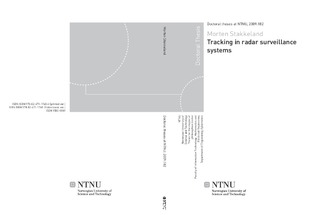| dc.contributor.advisor | Hallingstad, Oddvar | nb_NO |
| dc.contributor.advisor | Overrein, Øyvind | nb_NO |
| dc.contributor.author | Stakkeland, Morten | nb_NO |
| dc.date.accessioned | 2014-12-19T14:01:06Z | |
| dc.date.available | 2014-12-19T14:01:06Z | |
| dc.date.created | 2010-01-10 | nb_NO |
| dc.date.issued | 2009 | nb_NO |
| dc.identifier | 285022 | nb_NO |
| dc.identifier.isbn | 978-82-471-1760-6 (printed ver.) | nb_NO |
| dc.identifier.isbn | 978-82-471-1761-3 (electronic ver.) | nb_NO |
| dc.identifier.uri | http://hdl.handle.net/11250/259469 | |
| dc.description.abstract | The first part of this thesis focuses on the detection part of a radar surveillance system, and specifically derive methods for estimating the clutter density in a CFAR system from scan to scan, by making some basic assumptions on the system configuration. It is shown how the gain in applying a Bayesian estimator depend on the system configuration, and the gain is analyzed for some well known CFAR configurations. As an intermediate result, the variance of the clutter density for some CFAR configurations is derived. It is indicated how the derived variance may be a useful tool in the analysis of CFAR systems. Empirical Bayesian estimation is introduced as a way to apply optimal Bayesian estimation even though the prior density of the estimated random variable is unknown. Empirical Bayesian estimators in general use past data to estimate the prior density of the current random variable. A linear empirical Bayesian (LEB) estimator is applied to estimate the clutter density in the CFAR case, and it is shown that the LEB estimators converge to the corresponding linear Bayesian estimators as the set of past data gets large. The LEB estimators use the sample mean and variance of past measurements as inputs to estimate the current realization of the estimated random variable, or estimatee. The second part of this thesis is related to modeling of the errors in surveillance radar position measurements, and developing estimation filters that incorporate the models into tracking systems in an optimal manner. Monte Carlo simulations using simplified rectangular target models and simplified models of the components in radar surveillance systems are used to generate large data sets of simulated measurements. The parameters of the proposed measurement error models are then estimated from the data sets, using maximum likelihood estimation methods. It is shown that there may be a correlation between the aspect angle of the target and position measurement errors when the target is extended relative to the resolution of the system. In tracking systems it is commonly assumed that no such correlation exists and that the measurement errors in range and bearing are independent. In this thesis, two new measurement models are proposed. One proposed model assumes that the measurement noise is independent of the bearing angle, but dependent on the aspect angle. A second proposed model incorporates dependencies on both aspect angle and bearing angle in the measurement equation. Several state dependent measurement equations are also proposed to model biases that in some applications may be present in surveillance radar measurements. A discussion is given on how the standard Kalman filter fails to provide optimal estimates in cases where the measurement noise is dependent on the state vector of the target, and best linear unbiased estimation (BLUE) filters are hence derived in order to apply optimal filtering in this case. It is shown how higher order unscented transforms may be used to approximate the terms of the recursive BLUE filter, and that a third order unscented transform fails to provide sufficient accuracy. Some simulation results show how the BLUE filters in some cases has better root mean square error (RMSE) performance than suboptimal Kalman filters that use the standard measurement models. Simulations using simulated radar measurements also show that the proposed new model that includes dependency on both bearing and aspect angle has the best performance at all ranges, while the model assuming uncorrelated noise in range and bearing is good at long range where the target becomes a point target. A tool developed to generate trajectories consisting of random sequences of maneuvers is used in the simulations to generate a large number of random trajectories. This tool proves to be useful when analyzing the performance of the tracking filters, as it introduces the opportunity to analyze estimation filter performance as a function of a number of different kinematic parameters on trajectories that have dynamics that are realistic for the considered application. | nb_NO |
| dc.language | eng | nb_NO |
| dc.publisher | NTNU | nb_NO |
| dc.relation.ispartofseries | Doctoral Theses at NTNU, 1503-8181; 2009:182 | nb_NO |
| dc.subject | Tracking | en_GB |
| dc.subject | sensor modeling | en_GB |
| dc.subject | data fusion | en_GB |
| dc.subject | statistical estimation | en_GB |
| dc.subject | nonlinear filtering | en_GB |
| dc.title | Tracking in radar surveillance systems | nb_NO |
| dc.type | Doctoral thesis | nb_NO |
| dc.source.pagenumber | 104 | nb_NO |
| dc.contributor.department | Norges teknisk-naturvitenskapelige universitet, Fakultet for informasjonsteknologi, matematikk og elektroteknikk, Institutt for teknisk kybernetikk | nb_NO |
| dc.description.degree | PhD i elektronteknikk | nb_NO |
| dc.description.degree | PhD in Electrical Engineering | en_GB |

